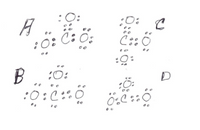
Chemistry
10th Edition
ISBN: 9781305957404
Author: Steven S. Zumdahl, Susan A. Zumdahl, Donald J. DeCoste
Publisher: Cengage Learning
expand_more
expand_more
format_list_bulleted
Concept explainers
Question
thumb_up100%
7.
Which of the preceding Lewis structures is correct for CO3−2

Transcribed Image Text::O:
:0: C:0:
B :ö:
:0:C
::
Expert Solution
This question has been solved!
Explore an expertly crafted, step-by-step solution for a thorough understanding of key concepts.
This is a popular solution
Trending nowThis is a popular solution!
Step by stepSolved in 2 steps

Knowledge Booster
Learn more about
Need a deep-dive on the concept behind this application? Look no further. Learn more about this topic, chemistry and related others by exploring similar questions and additional content below.Similar questions
- Please don't provide handwriting solutionarrow_forwardDraw a Lewis Structure for COCl2 in which all atoms have formal charges of zero.arrow_forwardWhen drawing the Lewis structure of the HCC13 molecule, the structure should represent a total of 26 valence electrons. What is the best description of the complete Lewis structure of the molecule? Select one: AH atom should be in the center with single bonds to each Cl atom and a double bond to the C atom. A Cl atom should be in the center with a single bond to the C atom and a single bond to the H atom. AC atom should be in the center with a double bond to the H atom and double bonds to each Cl atom. AC atom should be in the center with single bonds to each Cl atom and a single bond to the H atom.arrow_forward
- Consider the perbromate (BrO4) anion. What is the central atom? Enter its chemical symbol. How many lone pairs are around the central atom? What is the ideal angle between the bromine-oxygen bonds? Compared to the ideal angle, you would expect the actual angle between the bromine-oxygen bonds to be ... 0 口。 (choose one) X 3arrow_forwardHow many lone pairs are there on the central C atom in the Lewis structure for CH4 ? How many lone pairs are there on the central C atom in the Lewis structure for CH4 ? 1 3 4 0 2arrow_forwardDecide whether these proposed Lewis structures are reasonable. proposed Lewis structure :Z: I :Z: c=0 0 0 0 Is the proposed Lewis structure reasonable? O Yes. O No, it has the wrong number of valence electrons. The correct number is: O O No, it has the right number of valence electrons but doesn't satisfy the octet rule. The symbols of the problem atoms are:* ■ Yes. No, it has the wrong number of valence electrons. The correct number is: No, it has the right number of valence electrons but doesn't satisfy the octet rule. The symbols of the problem atoms are:* O Yes. O No, it has the wrong number of valence electrons. The correct number is: No, it has the right number of valence electrons but doesn't satisfy the octet rule. The symbols of the problem atoms are:* * If two or more atoms of the same element don't satisfy the octet rule, just enter the chemical symbol as many times as necessary. For example, if two oxygen atoms don't satisfy the octet rule, enter "0,0". X 3arrow_forward
- Consider the phosgene (COC1₂) molecule. What is the central atom? Enter its chemical symbol. How many lone pairs are around the central atom? What is the ideal angle between the carbon-chlorine bonds? Compared to the ideal angle, you would expect the actual angle between the carbon-chlorine bonds to be... 0 口。 (choose one) (choose one) about the same bigger smallerarrow_forward4. Ortho-Dichlorobenzene, C6H4Cl2, is obtained when two of the adjacent hydrogen atoms in benzene are replaced with Cl atoms. A skeleton of the molecule is shown here. a. Complete a Lewis structure for the molecule using bonds and electron pairs as needed. b. Are there any resonance structures for the molecule? If so, sketch them. c. Are the resonance structures in (a) and (b) equivalent to one another as they are in benzene? H H-C H C-Harrow_forwardDraw the Lewis structure of TeOF2 (by following the octet rule on all atoms) and then determine the ideal bonding angle (s) of the central atom.arrow_forward
- Determine the number of valence electrons in (CH₃C(O)CN) and then draw the corresponding Lewis structure.arrow_forward1. Write the Lewis symbols for the following atoms:(a) Kr; (b) Ge; (c) N; (d) Ga; (e) Ace; (f) Rbarrow_forwardDraw a Lewis Structure for the following molecules and show formal charges where appropriate: CO2 H,CNH,* CH,OHarrow_forward
arrow_back_ios
arrow_forward_ios
Recommended textbooks for you
 ChemistryChemistryISBN:9781305957404Author:Steven S. Zumdahl, Susan A. Zumdahl, Donald J. DeCostePublisher:Cengage Learning
ChemistryChemistryISBN:9781305957404Author:Steven S. Zumdahl, Susan A. Zumdahl, Donald J. DeCostePublisher:Cengage Learning ChemistryChemistryISBN:9781259911156Author:Raymond Chang Dr., Jason Overby ProfessorPublisher:McGraw-Hill Education
ChemistryChemistryISBN:9781259911156Author:Raymond Chang Dr., Jason Overby ProfessorPublisher:McGraw-Hill Education Principles of Instrumental AnalysisChemistryISBN:9781305577213Author:Douglas A. Skoog, F. James Holler, Stanley R. CrouchPublisher:Cengage Learning
Principles of Instrumental AnalysisChemistryISBN:9781305577213Author:Douglas A. Skoog, F. James Holler, Stanley R. CrouchPublisher:Cengage Learning Organic ChemistryChemistryISBN:9780078021558Author:Janice Gorzynski Smith Dr.Publisher:McGraw-Hill Education
Organic ChemistryChemistryISBN:9780078021558Author:Janice Gorzynski Smith Dr.Publisher:McGraw-Hill Education Chemistry: Principles and ReactionsChemistryISBN:9781305079373Author:William L. Masterton, Cecile N. HurleyPublisher:Cengage Learning
Chemistry: Principles and ReactionsChemistryISBN:9781305079373Author:William L. Masterton, Cecile N. HurleyPublisher:Cengage Learning Elementary Principles of Chemical Processes, Bind...ChemistryISBN:9781118431221Author:Richard M. Felder, Ronald W. Rousseau, Lisa G. BullardPublisher:WILEY
Elementary Principles of Chemical Processes, Bind...ChemistryISBN:9781118431221Author:Richard M. Felder, Ronald W. Rousseau, Lisa G. BullardPublisher:WILEY

Chemistry
Chemistry
ISBN:9781305957404
Author:Steven S. Zumdahl, Susan A. Zumdahl, Donald J. DeCoste
Publisher:Cengage Learning

Chemistry
Chemistry
ISBN:9781259911156
Author:Raymond Chang Dr., Jason Overby Professor
Publisher:McGraw-Hill Education

Principles of Instrumental Analysis
Chemistry
ISBN:9781305577213
Author:Douglas A. Skoog, F. James Holler, Stanley R. Crouch
Publisher:Cengage Learning

Organic Chemistry
Chemistry
ISBN:9780078021558
Author:Janice Gorzynski Smith Dr.
Publisher:McGraw-Hill Education

Chemistry: Principles and Reactions
Chemistry
ISBN:9781305079373
Author:William L. Masterton, Cecile N. Hurley
Publisher:Cengage Learning

Elementary Principles of Chemical Processes, Bind...
Chemistry
ISBN:9781118431221
Author:Richard M. Felder, Ronald W. Rousseau, Lisa G. Bullard
Publisher:WILEY